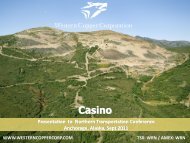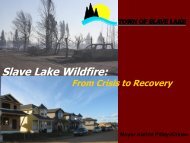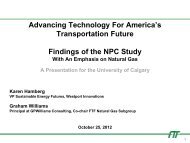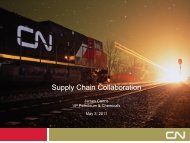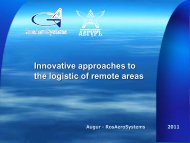Paul Murchison, Project Engineer, Transportation Engineering ...
Paul Murchison, Project Engineer, Transportation Engineering ...
Paul Murchison, Project Engineer, Transportation Engineering ...
You also want an ePaper? Increase the reach of your titles
YUMPU automatically turns print PDFs into web optimized ePapers that Google loves.
Stabilizing Highways OverDegrading PermafrostYukon, CanadaPresented by: <strong>Paul</strong> <strong>Murchison</strong>Northern <strong>Transportation</strong>Conference 2011:Circumpolar Challenges andOpportunitiesAnchorage AlaskaSeptember 18-20, 2011
Outline• Yukon Highway Infrastructure• Infrastructure Maintenance Issues• Yukon Climate Trends and Scenarios• Mitigation Measures/Permafrost Protection (PermafrostTest Site)• Results of Data Analysis, Permafrost Test Site
Yukon Highway Infrastructure• Area 483,450 km 2• Population ~35,000• 4,808 km of maintainedhighway– Asphalt pavement 310 km;– BST 1,930 km;– Gravel 2,568 km; and– 28 bridges.• About 25% of the highwayinfrastructure is underlain bypermafrost.
Yukon Highway InfrastructurePermafrost Test Site
Infrastructure Maintenance IssuesWarm, thaw sensitive permafrost = problems
Infrastructure Maintenance IssuesThaw Sensitive
BCIInfrastructure Maintenance IssuesCLASS 3 BST PERFORMANCE8580757065600 1 2 3 4 5 6 7 8 9 10 11 12 13 14 15 16AGE (Years)Class 3 - No Permafrost Class 3 - Permafrost TriggerTrend - All Other Class 3Trend - Class 3 Permafrost• Additional maintenance / rehabilitation cost in the permafrostsection is up to $22,000 / km / year• Maintenance / rehabilitation costs in permafrost sections areapproximately 8 times as much as non-permafrost sections
Infrastructure Maintenance Issues
Infrastructure Maintenance IssuesPermafrost deteriorationis expected to continueand possibly acceleratebased on observed andpredicted warming trends
Yukon Climate TrendsMayo• Evidence of awarming trendfrom observationsin:– Dawson City– Mayo– Watson Lake– Whitehorse– Beaver Creek
Yukon Climate TrendsData Source: Environment Canada
Yukon Climate TrendsData Source: Environment Canada• Observed mean winter air temperatures rate of change is 1.6 timesgreater than mean summer air temperatures.• Mean annual air temperatures increasing at 0.6 o C per decade (1969and 2006).
Data Source: SNAP(2010)Yukon Climate Scenarios
Permafrost Test Section – Alaska Highway• Twelve instrumented test sections.• The test site is heavily instrumented over 300 thermisters, 150 surfacetemperature loggers, heat flux plates, groundwater sensors and weathermonitoring equipment (air temperature, snow depth, wind speed anddirection).• Temperatures are recorded hourly and transmitted by satellite every fourhours to the GOY SCADA (Supervisory Control and Data Acquisition)server in Whitehorse.
Air Convection Embankment (ACE)• Constructed using 150 mm to 300 mm, crushed,rock to form interconnected, convective cells inthe embankment.– Winter – air cooled in the upper voids travels downinto the embankment displacing warm air whichrises and exits from the embankment.– Summer – the rock insulates the ground andreduces warming by keeping warm air near thesurface and cool air at the base of the ACE.
Longitudinal Culverts• Heat extraction by naturalconvection.– Winter, cold air is drawn intothe embankment at the inletand warmed air exits at theoutlet.OutletInlet– Summer, inlet and outlet areblocked to minimize warm airinput.
Heat Drains• Heat extraction by natural convectioninduced in a geocomposite layer• Applications on embankment slope andacross full embankment width
Sun/Snow Shed• Winter – promote air circulationand protect embankment slopesfrom snow insulation.• Summer – Reflects solarradiation and drastically reducesdrastically the effect on exposedslopes
• Light-coloured aggregateBST reflects solar radiationresulting decreasing heattransfer into theembankment.High Albedo Surfacing
Grass Covered EmbankmentAffects of vegetation on permafrostunderlying embankment slopeSnow ClearingClearing the snow from the side slopesduring winter to minimize the insulatingeffect
Data Analysis Results
Summary• Roads constructed on permafrost (especially warm, thaw sensitivepermafrost) tend to deform due to permafrost degradation.• Climate warming trends may be accelerating this degradation.• Stable highway sections may be destabilized in the future.• Permafrost protection techniques may prevent permafrost thawresulting from thermal regime changes due to:– highway construction and/or– warmer air temperatures
Thank you





